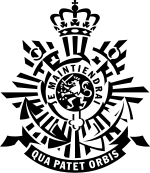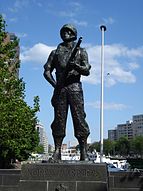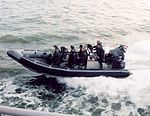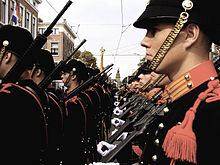- Netherlands Marine Corps
-
Korps Mariniers 
Badge and Insignia of the Korps MariniersActive 10 December 1665 - present Country Netherlands Branch Navy Type Marine Corps Role Rapid Reaction Force/Commando infantry/Light infantry/Naval infantry Size 4 battalions Part of Koninklijke Marine Garrison/HQ 1e Mariniersbataljon - Doorn
2e Mariniersbataljon - Doorn
3e Mariniersbataljon - Aruba/Curaçao
Amfibisch Gevechtssteunbataljon - Doorn/Texel
Logistiek Bataljon - DoornMotto Qua Patet Orbis ("As Far As The World Extends") Commanders Ceremonial chief HM The Queen The Korps Mariniers is the marine corps and amphibious infantry component of the Royal Netherlands Navy. The marines are trained to operate anywhere in the world in all environments, under any condition and circumstance, as a rapid reaction force. The Korps Mariniers can be deployed to a given location within 48 hours. Their motto is Qua Patet Orbis ("As Far As The World Extends").
Contents
History
The corps was founded on 10 December 1665 during the Second Anglo-Dutch War by the unofficial leader of the Dutch Republic, Johan de Witt, and Admiral Michiel de Ruyter as the Regiment de Marine. Its leader was Willem Joseph van Ghent. The Dutch had successfully used ordinary soldiers in ships at sea in the First Anglo-Dutch War. It was the fifth European Marine unit formed, being preceded by the Spain's Infantería de Armada (1537), the Portuguese Marine Corps (1610), France's Troupes de marine (1622), and the English Royal Marines (1664). Like Britain, the Netherlands has had several periods when its Marines were disbanded. The Netherlands itself was under French occupation or control from 1810 until 1813. A new Marine unit was raised on 20 March 1801 during the time of the Batavian Republic and on 14 August 1806 the Korps Koninklijke Grenadiers van de Marine was raised under King Louis Bonaparte. The modern Korps Mariniers dates from 1814, receiving its current name in 1817.
The battle honours on the Korps Mariniers' colors are:
Chatham
(1667)Kijkduin
(1673)Senneffe
(1674)Spain
(1702-13)West Indies
(1764 . 1772-77)Dogger Bank
(1781)Algiers
(1816)Bali
(1846-49)Aceh
(1873-76)Rotterdam
(1940)Java Sea
(1942)East Java
(1942)Java and Madura
(1946–49)New Guinea
(1962)Cambodia
1992-93 The Raid on Chatham, the first action of the Dutch marines in 1667
The Raid on Chatham, the first action of the Dutch marines in 1667
In 1667, led by van Ghent, now an admiral, and their new commander, the Englishman Colonel Thomas Dolman, the Regiment de Marine played a prominent part in the large Dutch raid, the "Raid on the Medway" on England (10–14 June). The Korps' battle honour "Chatham" is one of the few ever won on British soil by a foreign unit. The July 2nd attack on Landguard fort near Harwich, performed by 1.500 Mariniers after landing at Woodrich was beaten off by the fort's garrison.
The Mariniers also fought in the Franco-Dutch War/Third Anglo-Dutch War. On June 29, 1672, after serving in the naval Battle of Solebay (7 June), two-thirds of the Marines were withdrawn from the fleet and formed into a brigade in order to stiffen the inefficient and largely mercenary army in anticipation of an English invasion. They returned to their ships in time to help stop an English invasion by defeating a combined English and French force at the naval Battle of Kijkduin (Battle of Texel) on 21 August 1673. Led by Gerolf van Isselmuyden, they served in the land battle of Seneffe against the French in 1674.
Dutch support of American independence led to the Fourth Anglo-Dutch War, where the Mariniers served at Dogger Bank.
In 1704, Netherlands Marines were part of a combined English-Dutch force under Prince George of Hesse-Darmstadt that captured Gibraltar and defended it successfully shortly afterwards. They would combine with the British again for the bombardment of Algiers in 1816.
The Korps Mariniers served in some of the operations of the Netherlands in the Dutch East Indies colony. The Netherlands took a slow approach to conquering the entire colony and operations consolidating their rule lasted from the 1850s until shortly before World War I. The battle honors from the Aceh War (1873–1913) and Bali date from this time.
In World War II, a Korps Mariniers unit in Rotterdam preparing to ship out to the Dutch East Indies successfully defended the bridges across the Maas, preventing German paratroopers in the center of the city from rendezvousing with conventional German infantry. The Germans ended the stalemate by bombing Rotterdam. The threat of an attack by marines caused its German captain to scuttle the Antilla in Aruba in 1940.
When the surrender was declared and the Dutch soldiers came out of their positions, the German commander who was expecting a full battalion of men was stunned to see only a few Dutch Marines emerge in their black uniforms. He ordered his men to salute them out of respect for their bravery and determination and labeled them Zwarte duivels (The Black Devils).
 Marine Corps monument in Rotterdam
Marine Corps monument in Rotterdam
Some Mariniers later joined the Princess Irene Brigade to fight against the Germans. They distinguished themselves in combat near the Dutch city of Tilburg in the autumn of 1944.
Starting in 1943, the United States Marine Corps trained and equipped a new brigade, the Mariniersbrigade, of the Korps Mariniers at Camp Lejeune and Camp Davis in North Carolina in preparation for amphibious landings against the Japanese in the Dutch East Indies. The Japanese surrendered before such landings were needed, but the Mariniersbrigade, fully trained and equipped, left North Carolina in six transports in 1945 and fought against the Indonesians in their National Revolution for independence. It was part of the A Division, which was itself commanded by a Korps Mariniers officer. It was disbanded in 1949.
The Dutch kept Western New Guinea after the Indonesian National Revolution and the Korps Mariniers served there until 1962 when it was granted independence. The same year it was invaded and incorporated into Indonesia.
Modern Korps Mariniers
On 11 June 1977, the Bijzondere Bijstands Eenheid of the Dutch Marine Corps stormed a train that was being held hostage since 23 May by armed South Moluccan extremists in the village of De Punt, in the province of Drenthe. Six Royal Netherlands Air Force F-104 Starfighters buzzed the train as a diversion just before the assault. Six terrorists and two hostages were killed in the storming. The BBE has become the Dutch government's primary counter-terrorism force. (See "Combat Support Battalion" below.)
Lately the Marines have been deployed in various operations all over the world.
18 feb 1992 - 18 November 1993: United Nations Transitional Authority in Cambodia (UNTAC).- Three Battalion of Marines and a Navy field hospital (FDS)were stationed in Cambodia following the 1991 Paris peace treaty when the civil war was ended.
1995–present: Former Yugoslavia, Bosnia, Kosovo.
28 July 2000 - 7 February 2003: United Nations Mission in Ethiopia and Eritrea (UNMEE).Marines in The Hague wearing ceremonial uniforms
11 January 2002–July 2010: deployment in Afghanistan.
- Marines were deployed in Afghanistan as part of the International Security Assistance Force (ISAF) on several occasions. The second battalion with the field hospital was deployed in Mazar-e Sharif in 2005 to provide security during the elections. Marines and Navy personnel were also stationed in the Provincial Reconstruction Team in pol-e-Khomri, province of Baghlan. They took over from the Dutch Airforce and Army in 2005 and were relieved in October 2006 when Hungarian forces took over. Formerly Marines were serving in Uruzgan as NLD Operational Mentor and Liaisons Team, for recruiting and training new military personnel of the Afghan National Army in the Uruzgan province. Training took place at Kamp Holland, Tarin Kowt. A reinforced company was deployed in the Deh Rashan area of Uruzgan province. Two marines were killed on April 17, 2010, their BvS 10 Viking was hit by an IED.[1]
1 August 2003 - 2004: deployment in Iraq.
- Two battalions of marines were sent to Iraq after the second Gulf war as part of the stabilisation Force Iraq (SFIR). They were stationed in the province of Al-Muthanna where they fell under British command. Main base was located at camp Smitty in As Samawah. One company of marines was located at the village of Ar Rumaythah and one at the village of Al Khidr.
18 November 2003 - 19 February 2004: United Nations Mission in Liberia (UNMIL).
- One platoon of Dutch marines was deployed on board HNLMS Rotterdam, a Landing platform dock (LPD) of the Royal Netherlands Navy to provide logistical support for UNMIL landforces.
2005-2006: United Nations Organization Mission in the democratic Republic of the Congo (MONUC)
- Major General of the Marines Patrick Cammaert was appointed division commander by UN secretary general Kofi Annan.
The Corps celebrates its birthday each year at the Oostplein (lit., East Square) in Rotterdam, where all fallen (ex) corpsmembers are remembered.
On 29 May 2009, Marco Kroon, a member of the Korps Commandotroepen and a former member of the Netherlands Marine Corps, was awarded the Military William Order, the highest military decoration in The Netherlands. ě
Structure
All operational units of the Netherlands Marine Corps fall under the Marine Training Command (MTC).
The MTC is a brigade sized organisation which contains two of the three Marine Battalions (MARNSBATs) (the third being in the Caribbean), the Amphibious Combat Support Battalion (AMFGEVSTBAT) and the Amphibious Logistics Battalion (AMFLOGBAT)
Battalions
The Netherlands Marine Corps has 3 operational Marine Battalions. Two of those (1MARNSBAT and 2MARNSBAT) are stationed in the Netherlands. The 3rd Marine Battalion (3MARNSBAT) has only one active companie 32 INFCIE stationed on Aruba, 31 INFCIE on Curaçao was disbanded in 2009. 32 INFCIE is under direct command of the Navy Commander of the Caribbean (CZMCARIB)
1MARNSBAT is the main contribution of the Netherlands Marine Corps to the United Kingdom/Netherlands Landing Force (UK/NL LF). 2MARNSBAT was the core of the Dutch contribution to the ACE Mobile Force (Land) (AMF(L)), a now-disbanded fast intervention force of the Supreme Allied Commander Europe (SACEUR). 2MARNSBAT regularly participates in United Nations missions or other international operations.
1MARNSBAT
1MARNSBAT consists of:
- HQ Company
- 2 Infantry Companies: 11 Coy. is specialised Mountain and Arctic warfare and 13 Coy. is specialised in Jungle warfare and equipped with BvS 10 VIKING All Terrain Armoured Vehicles
- 14th Support Arms Company with Spike Anti-tank guided missiles, 81mm Mortars, Assault Engineers, Snipers and Reconnaissance Marines
2MARNSBAT
2MARNSBAT consists of:
- HQ Company
- 3x Infantry Companies: the 21st trained for Jungle warfare and riverine operations, the 22nd equipped with BvS 10 VIKING All Terrain Armoured Vehicles and the 23rd trained for Urban warfare
- 24th Support Arms Company with Spike ATGM, 81mm Mortars, Assault Engineers, Snipers and Reconnaissance Marines
Amphibious Combat Support Battalion
The Amphibious Combat Support Battalion consists of:
- 2x Boat Companies, that contain all amphibious landing craft as well as the Amphibious Beach Unit that supports landings from the beach
- Marine Joint Effect Battery, with 120mm Mortars, Joint Effects Observers and FIM-92 Stinger MANPADS
- Naval Special Operations Company
Amphibious Logistic Battalion
To operate successfully, the Marine Battalions need logistical support. This basically means providing transportation, supplies, food, housing, and mental and medical care. This duty is carried out by the Amphibious Logistic Battalion. Its personnel consists of both marines and navy personnel, forming a navy-marinecorps team. The commanding officer of AMFLOGBAT usually is a navy commander of the logistics branch. AMFLOGBAT has 2 tasks:
- Maintain MTCs units
- Provide MTCs units with the possibility to train and better themselves
AMFLOGBAT contains 3 companies:
- Combat Service Support 1 (supports 1MARNSBAT)
- Combat Service Support 2 (supports 2MARNSBAT)
- Seabased Support Group
Special Forces
The Maritime Special Operations Forces (MARSOF) is the new Special Forces format of the Marine Corps, after merging the Mountain Leader Reconnaissance Platoon, the Unit Interventie Mariniers and the frogman (combat divers) platoon.[2] The new Maritime SF training takes about 40 weeks, and eligible marines will be trained to become long-range reconnaissance/SF operators and maritime counter-terrorism specialists, with emphasis on maritime special operations (special operations conducted in water-rich environments, and conducted from sea to land). Those who wish to specialise for Mountain Leader or 'frogman' can apply for these specialisations following completion of the SF training. MARSOF is modeled after the British Special Boat Service.
Recruitment and Training
The Dutch Marine Corps is the oldest branch of the armed forces of the Netherlands.
There are two career possibilities to become a marine: enlisted marine, and marine officer, depending on the educational background.
Only men are allowed to serve as marines but many female navy personnel are attached to marine corps units as cooks, administrators, nurses or medical officers.
Initial training
Initial training to become an enlisted marine in the Netherlands lasts about 33 weeks (8 months - roughly equivalent to that of the British Royal Marines). It is given at the Mariniers Opleidingscentrum (M.O.C.) at the Van Ghentkazerne in Rotterdam. It is rigorous and very demanding, both physically and mentally, and eventually 33% to 50% will pass. If successfully completed, the recruits receive their "dark blue beret", and will be assigned to the operational units of Mariniers Training Commando (MTC).
Initial training to become a marine officer in the Netherlands lasts a total of 18 months, starting with a half-year general officer's training at the Koninklijk Instituut voor de Marine (Royal Dutch Naval Academy) and followed by an intensive 11 months of practical marine officer's training, regarded as the most demanding initial militairy training within the Dutch armed forces[citation needed] (POTOM - Praktische Opleiding tot Officier der Mariniers). This part of the initial training programme is modular, which means that it is made up of 3 phases. First, the prospective officers will learn the basic skills of every enlisted marine, which takes about 10 weeks. After phase one comes the second phase, commanding a troop (or squad) of 8 marines. This module lasts for 8 weeks, and emphasizes nightly operations. After successfully completing the second phase comes the final phase of commanding a platoon of marines. This last module is the longest, and cross-training is given by both the Dutch Marine training cadre and that of the British Royal Marines. If this is successfully completed, the marine officer will be assigned to the operational units of the Mariniers Training Commando (MTC).
Operational training
All Dutch marines are trained to operate in any environment, under any condition and circumstance. Therefore, Dutch marines regularly train in arctic, jungle, desert, high-altitude and urban conditions. Throughout their service, the marines embark on various training missions throughout the world. Amphibious warfare forms the heart of the marine corps, and this aspect is already implemented in the initial military training program. During operational training, there is more emphasis on various other tactics in amphibious warfare.
Specialisation
Experienced marines are able to obtain various specialisations. It is common for marines to have multiple specialisations. Popular specialisations include:
- Weapons Instructor
- Sports or PT Instructor
- Mortar specialist (120 mm mortar)
- Radio specialist
- Marksman
- Sniper
- Marine Scout
- Combat Life Saver
- Medic
- Free-fall parachutist
- Force Reconnaissance ("pathfinder")
- Special Forces (the Mountain Leaders and frogmen platoons have merged with the Unit Interventie Mariniers, creating the new Maritime Special Operations Force (MARSOF). Eligible marines will follow a 40 week special forces training course, after which they become long-range reconnaissance/SF operators and CT specialists. Graduates are able to specialise further as Mountain Leader or frogman.)
Some of these specialisations require the rank of Corporal before being able to follow specialisation training, and must not exceed a maximum age.
Equipment
Armour
- 156 BV206S armored all-terrain personnel carriers(127 will get a Mid-Life Update, the rest will be disposed of or sold)
- 74 BVS10 armored all-terrain personnel carriers
- 20 XA-188 wheeled armored personnel carriers(11 to be sold to Estonia, the rest will be disposed of or sold)
- 4 Leopard 1 BARV beach armored recovery vehicles
Artillery
- RT-120 (Habé Rayé) - 120mm mortar
- L16A2 - 81mm mortar
- Brandt MO-60-V - 60mm commando mortar
Landingcraft
- 5 L9525 LCU Mk2 - Landing craft utility
- 12 LCVP Mk5c - Landing craft vehicle personnel
- 46 Fast Raiding, Interception and Special Forces Craft, 11 for Special Operation use, 12 for use in the Dutch territories in the Caribbean, 17 for use as small landing crafts and 6 to use in combination with the new Holland Class OPV's
- Landing Craft Rubber (Motorized)
Other vehicles
- Land Rover Defender
- 40 Mercedes-Benz 280 CDI
- 17 Unimog 1.2-ton truck
- Various DAF trucks
Personal weapons
- Colt Canada C7A1 - 5.56x45mm NATO assault rifle
- Colt Canada C8A1 - 5.56x45mm NATO carbine
- Colt Canada C7 LSW - 5.56x45mm NATO light machinegun
- Glock 17 - 9x19mm Parabellum semi-automatic pistol
- FN MAG - 7.62x51mm NATO general purpose machinegun
- M2HB - .50 inch (12.7 mm) BMG (Browning Machine gun) heavy machinegun
- Steyr SSG 69 - 7.62x51mm NATO bolt-action sniper rifle
- Accuracy International AWM - .338 Lapua Magnum sniper rifle
- M107 - .50 BMG anti-materiel sniper rifle
- Barrett M99 - .50 BMG single-round anti-materiel sniper rifle
- Heckler & Koch MP5 - 9x19mm Parabellum submachine gun
- FN P90 - 5.7x28mm submachine gun
- Mossberg M590A1 - shotgun
- AT4 - anti-tank weapon
- Panzerfaust 3 - anti-tank weapon
- Gill - anti-tank missile
- FIM-92C Stinger - man-portable surface to air missile
- Hk416 - (MARSOF only)
- Sig Sauer P226 - (MARSOF only)
UK/NL landing force
See also: Netherlands – United Kingdom relations Marines in a Rigid-hulled inflatable boat
Marines in a Rigid-hulled inflatable boat
Since 1973, units of the Netherlands Marine Corps have formed part of the British 3 Commando Brigade during exercises and real conflict situations. Also, the 7th SBS NL troop will be placed under UK operational command as part of C Squadron, UK Special Boat Service. Together, these form the UK/NL Landing Force. Either the First or the Second Marine Battalion can be assigned as the Dutch contribution to this force.
The cooperation between the Korps Mariniers and the Royal Marines has led to extensive integration in the areas of operations, logistics and materials. Within NATO this is seen as a prime example of what can be achieved in military integration.
The RNLMC and Royal Marines have a long history of cooperation. During combined actions by the British and Dutch navies during the War of the Spanish Succession (1702–1713), amphibious operations were carried out, the most notable being the Siege of Gibraltar in 1704. During this action, a successful attack was carried out against the fortress of Gibraltar by an 1800-strong brigade of Dutch and British Marines under the command of Prince George of Hesse-Darmstadt. Both corps share this battle honour.
The British and Dutch armed forces share close relations. The Royal Marines and Netherlands Marine Corps are allied through a 'Bond of friendship'.[3]
The nickname of the Dutch Marines among their British Royal Marine counterparts is "Cloggies," due to the stereotype that most or all Dutch wear clogs, instead of "normal" footwear.
Alliances
 Royal Marines (Bond of Friendship)
Royal Marines (Bond of Friendship) United States Marine Corps (Bond of Friendship)
United States Marine Corps (Bond of Friendship)
References
- Beknopte geschiedenis Korps Mariniers
- Klein, Edwin,'The Dutch Marines and the Indonesian Problem', Marine Corps Gazette, Aug 1946.
- Dorren, C.J.O., De geschiedenis van het Nederlandsche Korps Mariniers van 1665-1945, 's Gravenhage, 1948.
- Coox, Alvin D., 'The Dutch Invasion of England: 1667', Military Affairs, Vol. 13 No. 4, Winter 1949, pp. 223–233.
- Dorren, C.J.O., 'Een historische terugblik op de ontsluiting van Japan na de maritieme strafexpedities tegen Kagoshima en Simonoseki (1863–1864)', Marineblad, 1950.
- Edwards, H. W., 'Netherlands Korps Mariniers', Marine Corps Gazette, Sep 1953.
- Dorren, C.J.O., Onze marineiersbrigade (1945–1949). Een veelbewogen episode in de korpsgeschiedenis, 's Gravenhage, 1955.
- Strandberg. Carl, 'Netherlands Marines', Marine Corps Gazette, Dec 1961.
- Bosscher, Ph. M., 'De gezantschapswacht te Peking', Marineblad, Vol. 75, 1965, pp. 1145–1198.
- Middelhoff, A.J.M., 'De geschiedenis van het 1ste Bataljon Marinetroepen', Marineblad, Vol. 79, 1969, pp. 627–642
- de Korver, Michael, 'Royal Netherlands Marines belong to the world's second oldest marine corps', Marine Corps Gazette, Feb 1979.
- Scharfen, 'Het Korps Mariniers' (interview), Marine Corps Gazette, Oct 1987.
- Schoonoord, D.C.L., De Mariniersbrigade 1943-1949 Wording en inzet in Indonesië, Instituut voor Maritieme Historie, The Hague, 1988.
- van Holst-Pellekaan, R.E., de Regst, I.C. and Bastiaans, I.F.J, Patrouilleren voor de Papoea's: de Koninklijke Marine in Nederlands Nieuw-Guinea 1945-1960, Amsterdam, 1989.
External links
- Official site of the Netherlands Marine Corps
- KorpsMariniers.com
- http://www.nimh.nl/korea_tot_kabul/index.html
References
Categories:- Royal Netherlands Marine Corps
- 1665 establishments
- Marines
Wikimedia Foundation. 2010.


